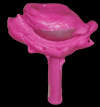Fabrication of Custom Eye Prosthesis for a 5-year-old with an Eviscerated Eye: A Case Report
- PMID: 40415739
- PMCID: PMC12096874
- DOI: 10.5005/jp-journals-10005-3079
Fabrication of Custom Eye Prosthesis for a 5-year-old with an Eviscerated Eye: A Case Report
Abstract
Aim and background: Loss of an eye due to congenital defects, trauma, tumors, or other conditions causes significant physical, emotional, and esthetic challenges to patients. Immediate replacement with an eye prosthesis is essential to improve physical, psychological, esthetic, and social acceptance of the patient.
Case description: This case report details a simplified approach for fabricating an ocular prosthesis for a 5-year-old boy who lost his eye following traumatic injury. The process of fabrication of the ocular prosthesis involved making a custom impression under general anesthesia and fabricating the ocular prosthesis using polymethylmethacrylate (PMMA) resin. The successful insertion of the prosthesis greatly enhanced the patient's appearance and social interactions, thereby improving his overall well-being.
Conclusion: Heat-cured acrylic resin-based prosthetic eye is a viable option for rehabilitation of an eviscerated eye. A custom-made ocular prosthesis using heat-cured acrylic resin was inserted into the eviscerated socket, and instructions regarding insertion, removal, hygiene, and maintenance were explained to the patient.
Clinical significance: Prosthetic rehabilitation of the loss of an eye improves psychosocial behavior, enhances the patient's self-confidence, and social acceptance. The eye prosthesis provides comfort to the patient from the psychological trauma that occurs due to the loss of an eye.
How to cite this article: Netalkar PP, Grover R, Shetty R, et al. Fabrication of Custom Eye Prosthesis for a 5-year-old with an Eviscerated Eye: A Case Report. Int J Clin Pediatr Dent 2025;18(3):305-307.
Keywords: Case report; Customized ocular prosthesis; Eviscerated eye; Eye prosthesis; Maxillofacial prosthetics.
Copyright © 2025; The Author(s).
Conflict of interest statement
Source of support: Nil Conflict of interest: None Patient consent statement: The author(s) have obtained written informed consent from the patient's parents/legal guardians for publication of the case report details and related images.Conflict of interest: None
Figures
References
-
- Murphey PJ, Pitton RD, Schlossberg L, et al. The development of acrylic eye prosthesis at the National Naval Medical Center. J Am Dent Assoc. 1945;32(19):1227–1244. doi: 10.14219/jada.archive.1945.0182. - DOI
Publication types
LinkOut - more resources
Full Text Sources
Miscellaneous







